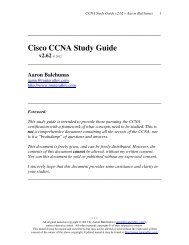OSI Reference Model - Router Alley
OSI Reference Model - Router Alley
OSI Reference Model - Router Alley
Create successful ePaper yourself
Turn your PDF publications into a flip-book with our unique Google optimized e-Paper software.
<strong>OSI</strong> <strong>Reference</strong> <strong>Model</strong> v1.31 – Aaron Balchunas<br />
4<br />
<strong>OSI</strong> <strong>Model</strong> - The Presentation Layer<br />
The Presentation layer (Layer-6) controls the formatting and syntax of user<br />
data for the application layer. This ensures that data from the sending<br />
application can be understood by the receiving application.<br />
Standards have been developed for the formatting of data types, such as text,<br />
images, audio, and video. Examples of Presentation layer formats include:<br />
• Text - RTF, ASCII, EBCDIC<br />
• Images - GIF, JPG, TIF<br />
• Audio - MIDI, MP3, WAV<br />
• Movies - MPEG, AVI, MOV<br />
If two devices do not support the same format or syntax, the Presentation<br />
layer can provide conversion or translation services to facilitate<br />
communication.<br />
Additionally, the Presentation layer can perform encryption and<br />
compression of data, as required. However, these functions can also be<br />
performed at lower layers as well. For example, the Network layer can<br />
perform encryption, using IPSec.<br />
<strong>OSI</strong> <strong>Model</strong> - The Session Layer<br />
The Session layer (Layer-5) is responsible for establishing, maintaining,<br />
and ultimately terminating sessions between devices. If a session is broken,<br />
this layer can attempt to recover the session.<br />
Sessions communication falls under one of three categories:<br />
• Full-Duplex – simultaneous two-way communication<br />
• Half-Duplex – two-way communication, but not simultaneous<br />
• Simplex – one-way communication<br />
Many modern protocol suites, such as TCP/IP, do not implement Session<br />
layer protocols. Connection management is often controlled by lower layers,<br />
such as the Transport layer.<br />
The lack of true Session layer protocols can present challenges for highavailability<br />
and failover. Reliance on lower-layer protocols for session<br />
management offers less flexibility than a strict adherence to the <strong>OSI</strong> model.<br />
* * *<br />
All original material copyright © 2012 by Aaron Balchunas (aaron@routeralley.com),<br />
unless otherwise noted. All other material copyright © of their respective owners.<br />
This material may be copied and used freely, but may not be altered or sold without the expressed written<br />
consent of the owner of the above copyright. Updated material may be found at http://www.routeralley.com.

















